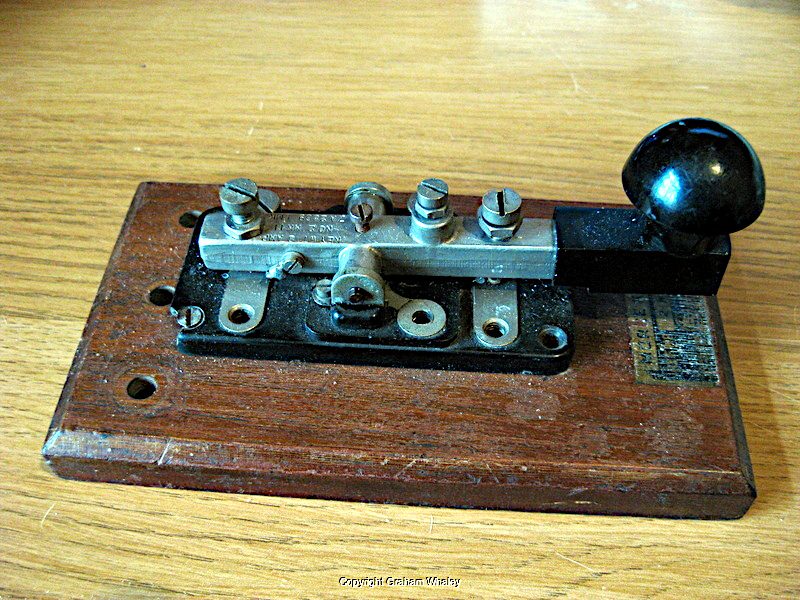
My first key! Well, I had to start somewhere. I had limited knowledge about morse keys, and didn’t want to blow the budget on a first unknown key, so was looking for something nice, well made (not junk), but at a reasonable (that is, cheap!) price. I know, I know, that would normally be a ‘pick any three’ scenario. I was hoping to trade off on looks and win on price and functionality.
I ended up with a WT 8 AMP as my first purchase.
The WT 8 AMP is fairly ubiquitous. There are many of them, and many styles of them. A good reference is the summary from the Morsum Magnificat magazine. In particulary, the WT 8 Amp reprints PDF has 57 pages of probably everything you could ever want to know about the WT 8 AMP key family.
The WT 8 AMP was a mainstay key of WWII. Literally millions were manufactured.
My specific key is a No.2 MKII ZA 2869 LMK. Looking at the Morsum reference above, it is likely the key was manufactured between 1940 and 1942.
I purchased my key off ebay in November 2020. I paid the princely sum of £14, delivered. The key was mounted on a base (see later), was a touch grubby, had one corner of the base broken, but generally was in useable shape:
It was a bit stiff - the spring return was slow, like it was gummed up. A look at the pivot pin showed it had some mild corrosion around the ends.
The base is interesting, in that it is a morse key base, but not for a WT 8 AMP. After some mild cleaning and staring, I worked out it is a base for a Signalling Equipment Ltd. No. 2.N.P key.
Oh, and one corner of the bakerlite base of the key has fractured off. Not the end of the world. In some ways that is a win for me, as slight damage that does not affect performance can mean I get a key cheap. I’m really not looking for a pristine key, as long as it is fully functional. And I rather enjoy cleaning and fixing them up.
First things first then - this key needs a clean. If nothing else we need to check out that corroded pivot pin. Let’s get it apart.
Taking this WT8 apart is not too hard. Pretty much undo the screw that is retaining the pivot pin, and push the pin out. Here you can then see the state of the key. It’s not terrible, but there is an accumulation of crud around the pivots, and the pin itself could do with a clean.
The pivot pin was a bit stiff to remove - I seem to remember I took off some of the corrosion on the very ends of the pin before pushing it through the pivot blocks and armature - no point forcing rust through those holes if you don’t need to.
Mostly I cleaned this with some mild soap and an old toothbrush. If I remeber rightly, I then used something like a garryflex block to clean up the pivot pin, and some mild metal polish to clean up the metal parts.
Now, what to do about that broken corner on the base. I resorted to my goto ‘gap filler’, epoxy putty. I used some milliput ‘standard’, as that is what I had to hand. I have since purchased a multi-pack of various colours of milliput, so would have used the black milliput if I had had it to hand.
Mix, apply, and once cured carefully file and sand it to shape.
Putting it back together is as easy as getting it apart. The pivot pin now slid into the pivot holes much easier than it came out, and didn’t have too much play.
Here is the cleaned up key, mounted on a new oak base. The screws I used have heads just a fraction larger than I’d like, and sit slightly proud, but they are what I had to hand. I had to be careful with that repaired corner, and in fact there is a slight crack opening up caused by the screwhead, but it is still functional.
Well, this being my first key, I didn’t really have a lot to compare it against. Since acquiring more keys though, my first impressions have been borne out - this key is quite ‘clacky’ - that is, loud, and has quite a hard stop. That’s not really to my liking. I can live with the noise if I have to, but the hard stop doesn’t feel nice to me. I gather as one gains experience then you might be able to transmit faster with a ‘hard’ key, but I’m just staring out, and want to try out some other keys to see if all keys feel like this or not…
Still, I’d say the key is not looking too bad for something probably 80 years old! As a first key, I’m pretty happy with it.